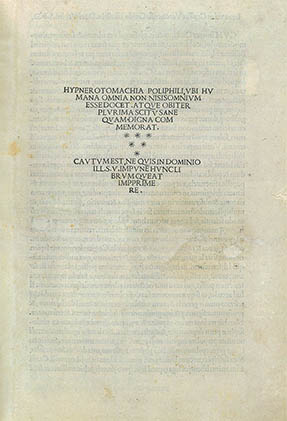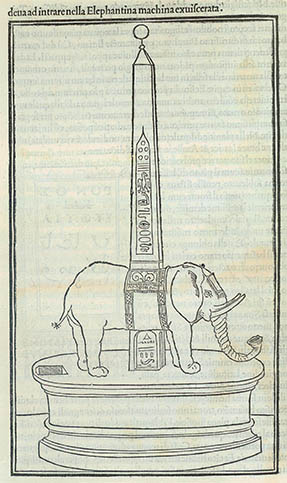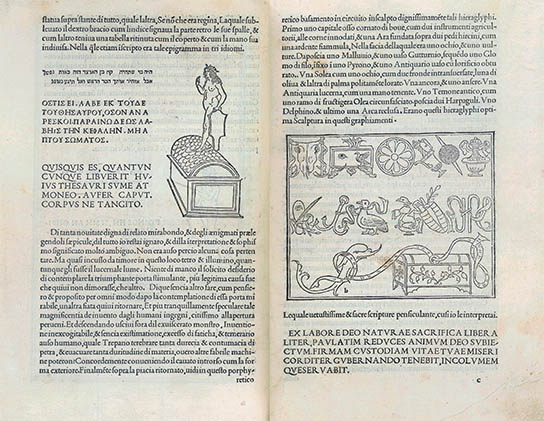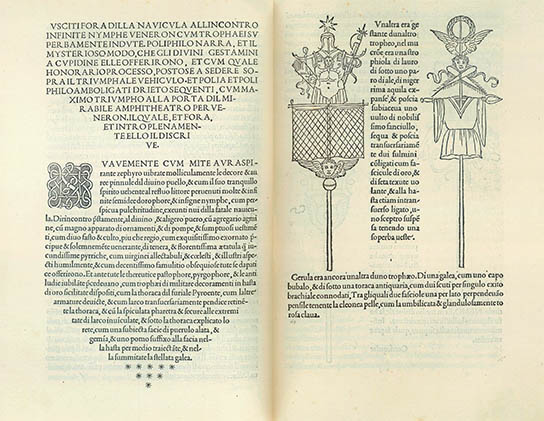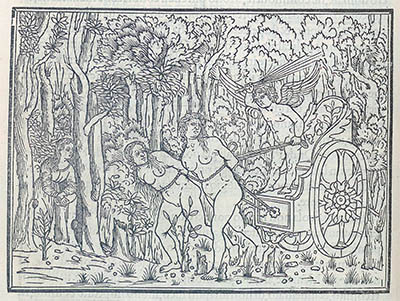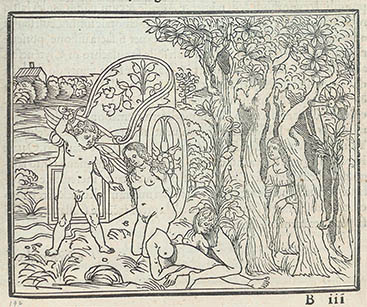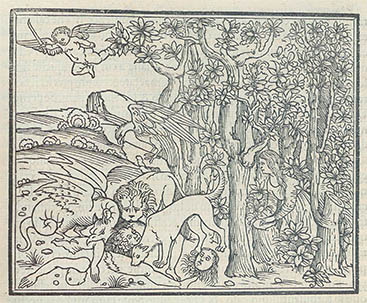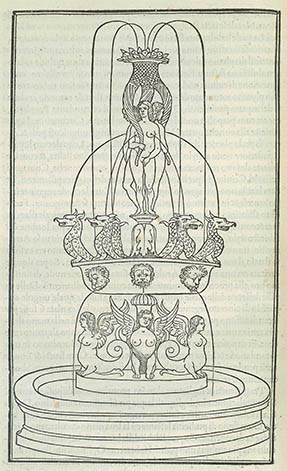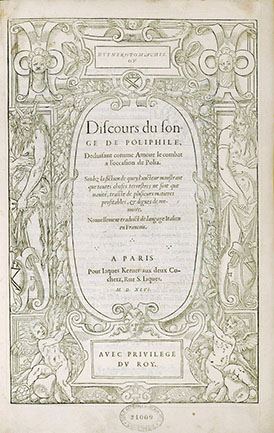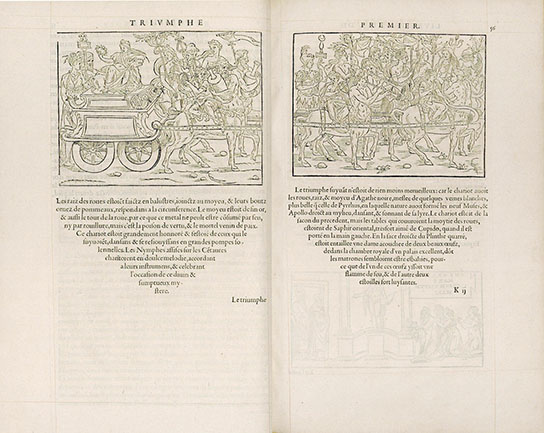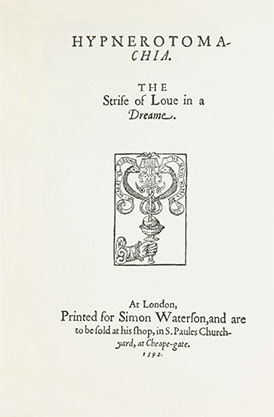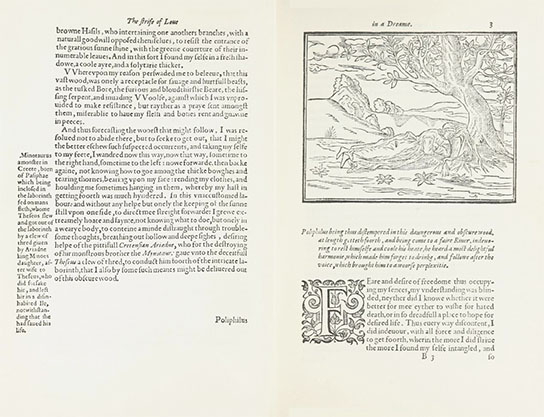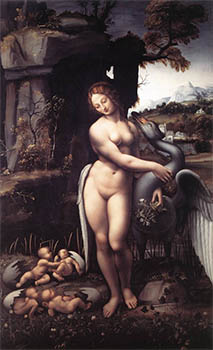Sacrifice to Priapus. Perhaps the most censored woodcut of the Renaissance. From ref 1
82
The Hypnerotomachia Poliphili
Illustrated books were becoming increasingly popular by the end of the 15th century. Malermi’s Biblia Italia was published in 1490, Schedel’s monumental Liber Chronicarum in 1493, and Durer’s Apocalypsis in 1498, to name just a few. The Aldine press, however, was much too busy with its scholarly works to bother with a picture-book – with one exception. This lone exception, the Hypnerotomachia Poliphili,2 would turn out to be not only the most celebrated book design of the Renaissance, but one of the most important and yet utterly bizarre and inscrutable books ever published.
THE HYPEROTMACHIA OF POLIPHIO, IN WHICH
IT IS SHOWN THAT ALL HUMAN THINGS
ARE BUT A DREAM, AND MANY
OTHER THINGS WORTHY
OF KNOWLEDGE AND
MEMORY
***
**
*
The story, attributed to the renegade Dominican friar Francesco Colonna,3 was part convoluted romanzo d’amore where Poliphio searches for his unrequited love Polia in a dream; part architectural critique, echoing the the work of the humanist polymath Leon Battista Alberti; and part catalog of contemporary humanist erudition, dense with references to Ovid, Virgil and Bacchicco.
You would he hard-pressed, however, to get any of that from the original text. It was written in a recondite latinate Italian where Colonna routinely made up his own words from Latin and Greek roots. He also added a smattering of Greek, Hebrew, Arabic and even hieroglyphs. It was nearly as unintelligible to 15th century Venetians as it is today.
A colossal elephant of black stone, with gold and silver dots. Upon the back of this prodigious animal is placed an obelisk of Verde-antique.
The book was commissioned by the Venetian nobelman Leonardo Crasso and printed by the Aldine press, according to the colophon on the errata page, in Dec 1499.4 It was Aldus’ first and only commission.
For the edition Aldus reused the roman lower-case from his 1459 edition of De Atnea but had Francesco Griffo cut a new majuscule based on the inscriptional models of Feliciano (see here). The result was Griffo’s most accomplished roman and the archetypical Renaissance letter.
The 172 woodcuts (including 39 floriated initials and 11 full-page illustrations) have been attributed to the Paduan miniaturist Benedetto Bordon (or Bordone). Although they are not as artistically ambitious as, e.g, the work of Durer, they show a wonderful sense of movement: panels are cut to show a scene across a page spread and in several cases successive panels illustrate the story in a nearly cinematic effect.
Aldus had no experience with illustrated books and must have worked directly with Bordon to design and layout the complicated page spreads. The result, a 39-line 1:1.7 textblock, for which the book is so justifiably celebrated, was an unprecedented integration of text and image. Experts have long commented on the perfect balance in the weight and color of the woodcuts and text, but the integration goes far beyond that. The pair designed pages where text flows around images, where images serve as text and where text is shaped into images. Here are a few illustrative page spreads:
The rebus spread
The Triumph of Leda5 (the second of four precessions)
Trophy of Roman Arms
And here is an example storyboard-like woodcut sequence:
The Dream of Polia: Cupid forces two women who resisted his power to to draw his chariot...
...then mercilessly slices their bodies into pieces...
...and floats triumphantly as a dragon, lion and wolf consume their remains
The entire project cost Crasso several hundred ducats and, as I am sure you can guess. the expensive, esoteric book did not sell very well.6 Ten years after its’ publication Crasso was still is possession of most of the copies and asked the Venetian council for an extension of his copyright.
The third fountain with the figures of the three graces
Aldus’ heirs reprinted the book in 1455, but it would be the French edition where the book saw its’ greatest success.
By the reign of Francis I (1515-1547) the book had become something of a Renaissance art and literature manifesto and Louis Bluublom commissioned the Parisian printer Jacques Kerver to print a French edition. The book, Discours du Songe de Poliphile, printed 20 Aug 1546, included a contemporary French translation by Jean Martin and a new set of woodblocks attributed to Jean Cousin.7 The title turned out to be both popular and influential. It was reprinted in folio in 1554 and 1561, and in quarto in 1600.
The Strife of Love in a Dreame, the first English edition, was translated by Sir Robert Dallington and printed in 1592 by Simon Waterson in London.8 The book, recast as a standard Elizabethan novel, included only a third of the original text and suffers from rather inexpert woodcuts.
Aldus’ novel typographical treatment wouldn’t be seen again until the avant-grade of the 1920s and the tight integration of text and image is, honestly, still a rarity even today.
Over the years the book has been the subject of thousands of analyses, commentaries, interpretations and appreciations, as well as hundreds of reprints, facsimiles and critical editions. It remains one of the most influential, yet enigmatic books ever written.
1. The images of the 1499 edition are from Carnegie Mellon’s Posner Center. There are a number of other complete copies online, including the Bayerische StaatsBiblothek, the Herzog August Bibliothek, and at lower resolution at the LOC, via Octavo and, of course the The Electronic Hypnerotomachia at the MIT Press. There are even more, but that’s what Google is for.
2. The title is a confected latinate Italian word from Greek roots: hypnos (πνος, sleep) + eros (ρως, love) + machē (μάχη, strife) and Polus (πολύς, many) + Philos (φίλος, beloved). The most popular, although not entirely accurate, English translation is “Strife of Love in a Dream.”
3. An acrostic from the decorated chapter initials reads POLIAM FRATER FRANCISCVS COLVMNA PERAMAVIT, “Brother Francesco Colonna has dearly loved Polia.” Minority views ascribe authorship to Lorenzo de Medici, Leon Battista Alberti, or even to Aldus Manutius himself. See: Lefaivre, Liane. Leon Battista Alberti’s Hypnerotomachia Poliphili.Cambridge: MIT Press, 1997.
4. The Hypnerotomachia Poliphili (ISTC ic00767000) was printed on 234 super-chancery 2° (299 × 194 mm, 1:1.54) paper folios (468 pages) and collated into 8-folio signatures. Because the book was not paginated, pages are referred to by signature (a–y) and leaf number (1–8 r,v); e.g. the first title page is a1r.
According to the ISTC record there are more than 200 full or partial copies still extant, and this dose not include privately-held copies. This, surprisingly, accounts for more than a third of the original edition.
5. In Greek mythology Leda, daughter of Thestius, married King Tyndareus, and was seduced by Zeus who took the form of a swan. Leta bore two eggs, which produced Helen of Troy and Polyduces (she also bore Tyndareus two children, Castor and Clytemnestra, by apparently more conventional means). The motif was popular in 16th century Italy. Here, as an example, is Cesare da Sesto’s copy (ca.1520) of the lost Leonardo version:
6. Durer reportedly paid an entire ducat for a copy in 1507. For comparison Jacopo de’ Barbari’s Pianta di Venezia, a monstrous 1.3 × 2.8 m wood block print, sold for 3 ducats in 1500 and Michelangelo was paid 400 ducats for his completed David in 1504.
7. A complete version of the 1546 French edition is available online at Architectura. for more about the book’s influence in France see: Blount, Anthony. The Hypnerotomachia Poliphili in 17th Century France. Journal of the Warburg and Courtauld Institutes. 1937 Oct;1(2): 117–137.
8. A complete version of the 1592 English version is available online at the Internet Archive. The first complete (modern) English translation was by the musicologist Joscelyn Goodwin; The Hypnerotomachia Poliphili: The Strife of Love in a Dream. London: Thames & Hudson, 1999.
4 Jan 2011 ‧ Typographia Historia

